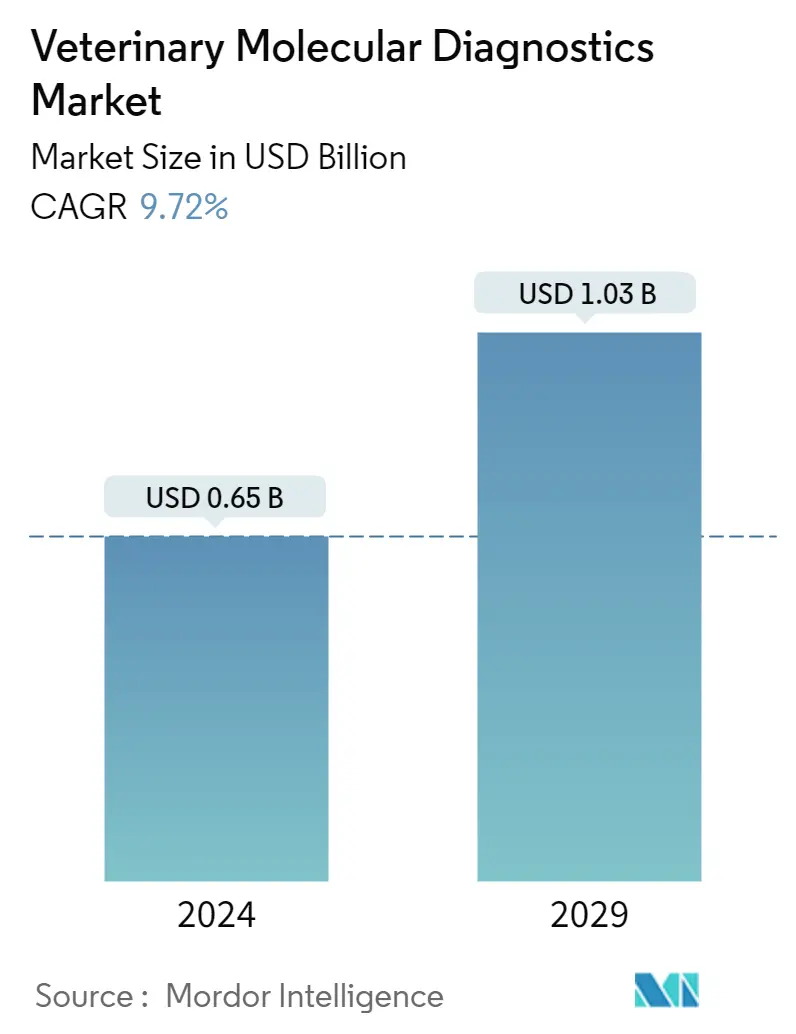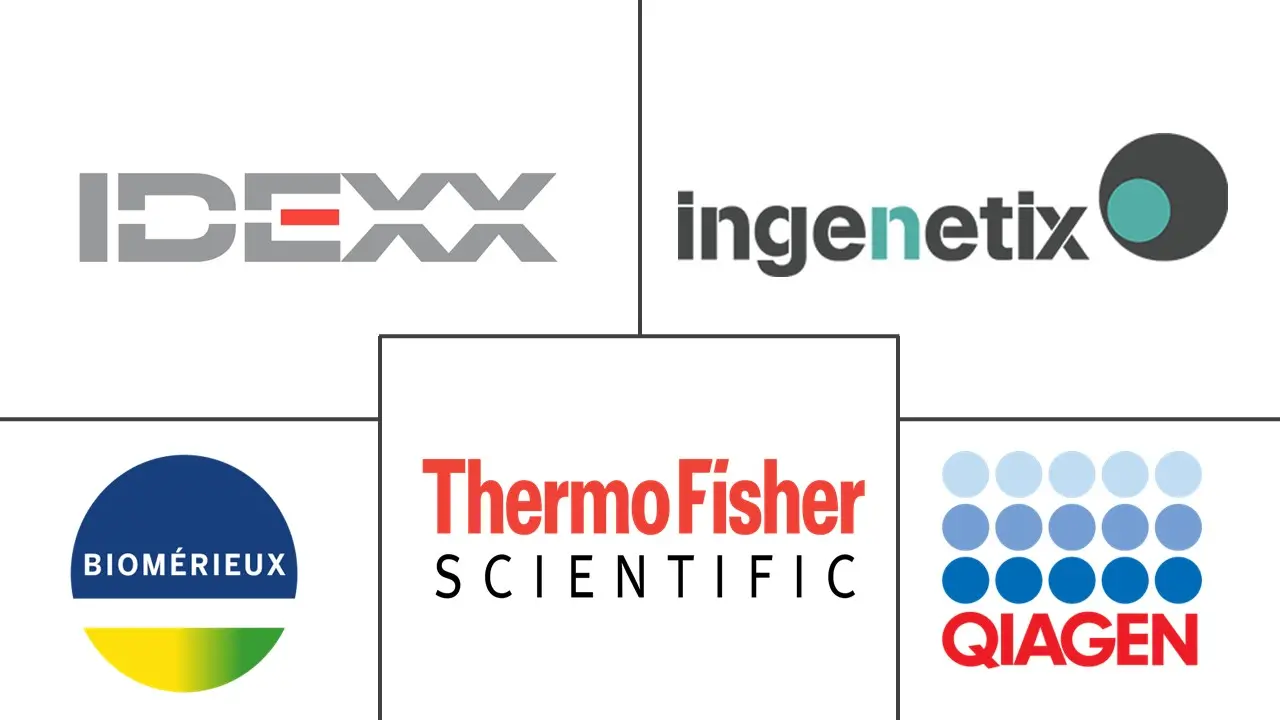Market Size of Veterinary Molecular Diagnostics Industry

| Study Period | 2019 - 2029 |
| Market Size (2024) | USD 0.65 Billion |
| Market Size (2029) | USD 1.03 Billion |
| CAGR (2024 - 2029) | 9.72 % |
| Fastest Growing Market | Asia-Pacific |
| Largest Market | North America |
Major Players
*Disclaimer: Major Players sorted in no particular order |
Veterinary Molecular Diagnostics Market Analysis
The Veterinary Molecular Diagnostics Market size is estimated at USD 0.65 billion in 2024, and is expected to reach USD 1.03 billion by 2029, growing at a CAGR of 9.72% during the forecast period (2024-2029).
The outbreak of COVID-19 had a significant impact on the veterinary molecular diagnostics market because healthcare services were significantly reduced due to social distancing measures taken by governments. The United Nations Office for the Coordination of Humanitarian Affairs, in its article published in the Food and Agriculture Organization of the United Nations in July 2021, indicated that the pandemic had direct impacts on account of movement restrictions and a fear of the spread of the virus infection, and indirect impacts that resulted from resources being directed away from animal health surveillance activities to COVID-19-related activities. In another article presented in the journal of Frontiers in Veterinary Science in February 2021, standard practices, such as routine animal check-ups and surgeries, were disrupted, and veterinary clinics and hospitals had to quickly modify standard protocols to safely serve their clients and patients. Thus, the COVID-19 pandemic had a pronounced impact on the growth of the market studied. However, the sector has been recovering since restrictions were lifted. An increase in veterinary visits and the reopening of veterinary clinics have been leading market recovery over the last two years.
Veterinary molecular diagnostics is primarily driven by the growing pet animal population worldwide, increased expenditures on animal health, and advancements in veterinary molecular diagnostics. According to the pet population data published in March 2021 by the Pet Food Manufacturers Association, over 59% of households in the United Kingdom had pets, with over 32.6 million pets in 2021. The trend of treating pets as family members is growing, which increases the demand for better healthcare and veterinary applications.
Moreover, the growing prevalence of animal diseases is expected to propel the growth of the market over the forecast period. According to a study published by the University of Calgary in June 2021, conducted to investigate the infections of Echinococcus multilocularis in domestic dogs to infer their potential role in zoonotic transmission, stated that Echinococcus multilocularis, a parasitic helminth of the northern hemisphere (Alberta, Canada), normally cycles through definitive and intermediate hosts. But in urban areas, domestic dogs can also become hosts for this parasite, which could become a significant risk factor to humans due to their proximity. An article by the government of Canada on reportable diseases in terrestrial animals, updated in February 2021, listed a number of diseases that affect animals, including companion animals in the region. The large list of diseases includes equine infectious anemia, equine piroplasmosis, Newcastle disease, Pullorum disease, and vesicular stomatitis, among others. The increase in the occurrence of diseases among companion animals in the region and the requirement for associated diagnostics will provide lucrative growth opportunities for the veterinary molecular diagnostics market.
As per the estimates of the American Pet Products Association published in April 2022, the total American pet industry expenditure reached USD 123.6 billion in 2021, up from USD 103.6 billion in 2020. The rise in animal health expenditure is expected to drive the growth of the veterinary molecular diagnostics market, as a significant portion of pet owners are expected to use advanced diagnostic modalities for various disease conditions in animals.
Various activities by key market players, such as mergers and acquisitions and partnerships, are expected to propel the growth of the market. For instance, in April 2022, Carolina Liquid Chemistries Corporation of Greensboro signed a semi-exclusive agreement to distribute a portable analyzer for the US market. The company will distribute the SeamatySMT-120 VP veterinary automated chemistry analyzer, a compact, fully automatic chemistry, electrolyte immunoassay, and coagulation analyzer for animal health diagnosis.
However, the lack of skilled personnel and the high cost of diagnostic tests are expected to slow down market growth over the forecast period.
Veterinary Molecular Diagnostics Industry Segmentation
As per the scope of the report, veterinary molecular diagnostics refer to the molecular diagnostic techniques that are employed to analyze samples from animals (companion, domestic, etc.). Veterinary molecular diagnostics primarily focuses on the detection, identification, and genotyping of pathogens. The veterinary molecular diagnostics market is segmented by products (instruments, kits and reagents, and software and services), applications (infectious diseases, genetics, and other applications), technology (PCR, microarray, and DNA Sequencing), and geography (North America, Europe, Asia-Pacific, Middle East and Africa, and South America). The report also covers the estimated market sizes and trends of 17 countries across major regions. The report offers all values in USD million for the above segments.
| By Product | |
| Instruments | |
| Kit and Reagents | |
| Software and Services |
| By Application | |
| Infectious Diseases | |
| Genetics | |
| Other Applications |
| By Technology | |
| PCR | |
| Microarray | |
| DNA Sequencing |
| Geography | ||||||||
| ||||||||
| ||||||||
| ||||||||
| ||||||||
|
Veterinary Molecular Diagnostics Market Size Summary
The veterinary molecular diagnostics market is poised for significant growth, driven by an increasing pet population, heightened animal health expenditures, and advancements in diagnostic technologies. The market experienced a temporary setback due to the COVID-19 pandemic, which disrupted routine veterinary services and redirected resources towards pandemic-related activities. However, the sector has shown resilience and is on a recovery path as veterinary clinics reopen and pet owners resume regular visits. The trend of treating pets as family members is further fueling demand for advanced veterinary healthcare solutions. The rising prevalence of animal diseases also presents lucrative opportunities for the market, as the need for effective diagnostics becomes more critical in managing and preventing these conditions.
North America is expected to dominate the veterinary molecular diagnostics market, supported by a growing trend of pet ownership and increased demand for animal-based proteins. The United States, in particular, is witnessing a surge in pet adoption and a rise in per capita animal healthcare spending, which are key factors driving market expansion. The region's market growth is further bolstered by numerous product launches focusing on innovative molecular diagnostics solutions. The competitive landscape is characterized by moderate fragmentation, with key players investing in research and development to enhance their market presence. Strategic activities such as mergers, acquisitions, and partnerships are also contributing to the market's dynamic growth trajectory.
Veterinary Molecular Diagnostics Market Size - Table of Contents
-
1. MARKET DYNAMICS
-
1.1 Market Overview
-
1.2 Market Drivers
-
1.2.1 Rise in Prevalence of Animal Diseases
-
1.2.2 Increase in Demand for Animal-derived Proteins
-
1.2.3 Growth in Animal Health Expenditure
-
-
1.3 Market Restraints
-
1.3.1 Lack of Skilled Personnel
-
1.3.2 High Cost of Diagnostic Tests
-
-
1.4 Porter's Five Forces Analysis
-
1.4.1 Threat of New Entrants
-
1.4.2 Bargaining Power of Buyers/Consumers
-
1.4.3 Bargaining Power of Suppliers
-
1.4.4 Threat of Substitute Products
-
1.4.5 Intensity of Competitive Rivalry
-
-
-
2. MARKET SEGMENTATION (Market Size by Value - in USD Millions)
-
2.1 By Product
-
2.1.1 Instruments
-
2.1.2 Kit and Reagents
-
2.1.3 Software and Services
-
-
2.2 By Application
-
2.2.1 Infectious Diseases
-
2.2.2 Genetics
-
2.2.3 Other Applications
-
-
2.3 By Technology
-
2.3.1 PCR
-
2.3.2 Microarray
-
2.3.3 DNA Sequencing
-
-
2.4 Geography
-
2.4.1 North America
-
2.4.1.1 United States
-
2.4.1.2 Canada
-
2.4.1.3 Mexico
-
-
2.4.2 Europe
-
2.4.2.1 Germany
-
2.4.2.2 United Kingdom
-
2.4.2.3 France
-
2.4.2.4 Italy
-
2.4.2.5 Spain
-
2.4.2.6 Rest of Europe
-
-
2.4.3 Asia-Pacific
-
2.4.3.1 China
-
2.4.3.2 Japan
-
2.4.3.3 India
-
2.4.3.4 Australia
-
2.4.3.5 South Korea
-
2.4.3.6 Rest of Asia-Pacific
-
-
2.4.4 Middle East and Africa
-
2.4.4.1 GCC
-
2.4.4.2 South Africa
-
2.4.4.3 Rest of Middle East and Africa
-
-
2.4.5 South America
-
2.4.5.1 Brazil
-
2.4.5.2 Argentina
-
2.4.5.3 Rest of South America
-
-
-
Veterinary Molecular Diagnostics Market Size FAQs
How big is the Veterinary Molecular Diagnostics Market?
The Veterinary Molecular Diagnostics Market size is expected to reach USD 0.65 billion in 2024 and grow at a CAGR of 9.72% to reach USD 1.03 billion by 2029.
What is the current Veterinary Molecular Diagnostics Market size?
In 2024, the Veterinary Molecular Diagnostics Market size is expected to reach USD 0.65 billion.

